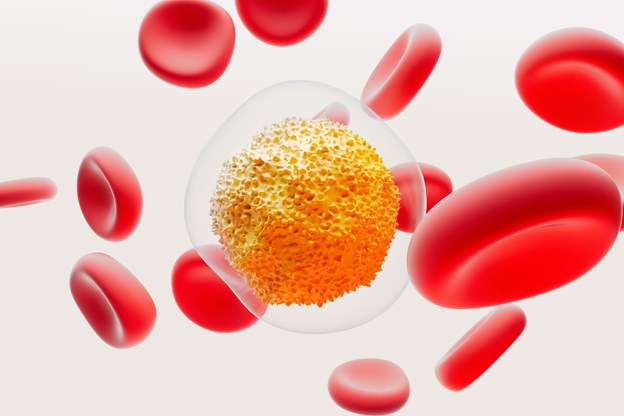
What is multiple myeloma?
- Multiple myeloma is the second most common blood cancer in the U.S., with an estimated 35,730 new cases to be diagnosed in 2023.1,2
- Multiple myeloma arises in a person’s bone marrow, when plasma cells mutate into problematic myeloma cells. These cells accumulate, crowding out healthy blood cells.3
What are the signs and symptoms of multiple myeloma?
- While some may not exhibit symptoms of multiple myeloma, once myeloma cells begin to crowd normal blood cells, symptoms often appear. Some signs and symptoms of multiple myeloma include:3,6
- Breakdown of the bone resulting in high levels of calcium in the blood (hypercalcemia), which causes dehydration, excessive thirst, nausea, constipation and confusion
- Poor kidney function
- Anemia that may result in weakness dizziness and shortness of breath
- Weakened bones making patients more susceptible to fractures
- Weakened immune system causing more infections such as pneumonia
- Fatigue
Who can be impacted by multiple myeloma?
While everyone can be impacted by multiple myeloma, it is more common in:
- People who are at least 65 years old.8 The risk of developing multiple myeloma increases with age.
- Men3 are slightly more likely to develop multiple myeloma.
- African Americans8 are at twice the risk of developing multiple myeloma compared to white Americans.
How is multiple myeloma diagnosed?
- Multiple myeloma is often diagnosed through several exams and tests. Most commonly, doctors may run a variety of specialized blood and/or urine tests, bone marrow examinations, x-rays or other imaging tests and genetic tests.3
How is multiple myeloma treated?
- Treatments for multiple myeloma work in different ways, so a person’s doctor may choose to combine various therapies including stem cell transplant, chemotherapy, corticosteroids, antibody therapy, immunomodulators and proteasome inhibitors.6
References
1 Kazandjian D. Multiple myeloma epidemiology and survival: A unique malignancy. Semin Oncol. 2016;43(6):676–681. doi:10.1053/j.seminoncol.2016.11.004.
2 American Cancer Society Cancer Statistics Center. Myeloma. https://cancerstatisticscenter.cancer.org/#!/cancer-site/Myeloma. Accessed March 2023.
3 Gertz MA. Multiple Myeloma. NORD (National Organization for Rare Disorders). https://rarediseases.org/rare-diseases/multiple-myeloma/. Published 2016. Accessed March 2023.
4 Seckinger A, et al. Cancer Cell. 2017;31(3):396–410.
5 Cho SF, et al. Front Immunol. 2018;9:1821.
6 Multiple myeloma. Genetic and Rare Diseases Information Center. https://rarediseases.info.nih.gov/diseases/7108/multiple-myeloma. Published 2016. Accessed March 2023.
7 National Cancer Institute. Multiple Myeloma Awareness and African American Disparities. https://www.cancer.gov/about-nci/organization/crchd/blog/2017/multiple-myeloma-disparities. Published April 2017. Accessed March 2023.
8 American Cancer Society. Risk Factors for Multiple Myeloma. https://www.cancer.org/cancer/multiple-myeloma/causes-risks-prevention/risk-factors.html#references Accessed March 2023.
9 Giuiani, N, et al. Expert Review of Hematology. 2019 12:7, 481-496.
10 Ishibashi M, et al. Oncotarget. 2018;9(78):34784-34793.
11 National Cancer Institute. NCI Dictionary of Cancer Terms. PD-1. https://www.cancer.gov/publications/dictionaries/cancer-terms/def/pd-1. Accessed March 2023.



